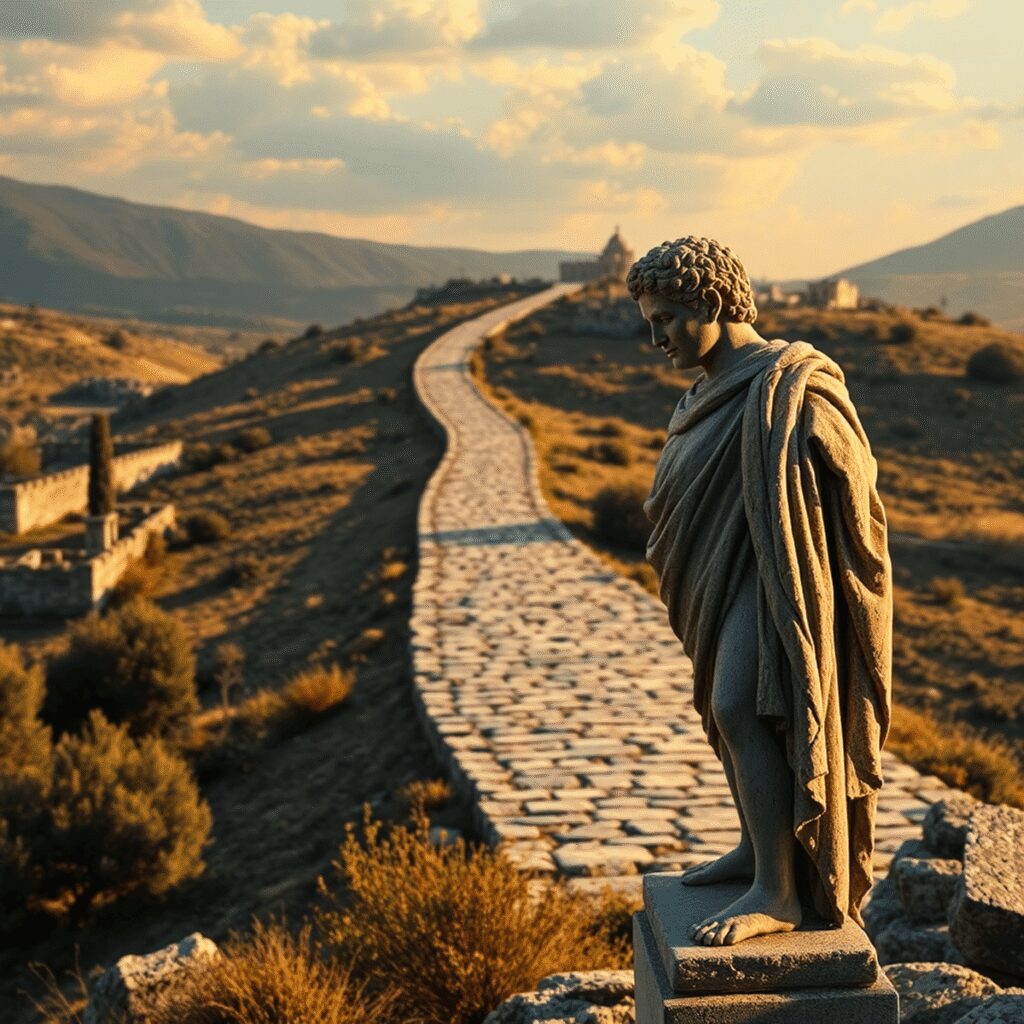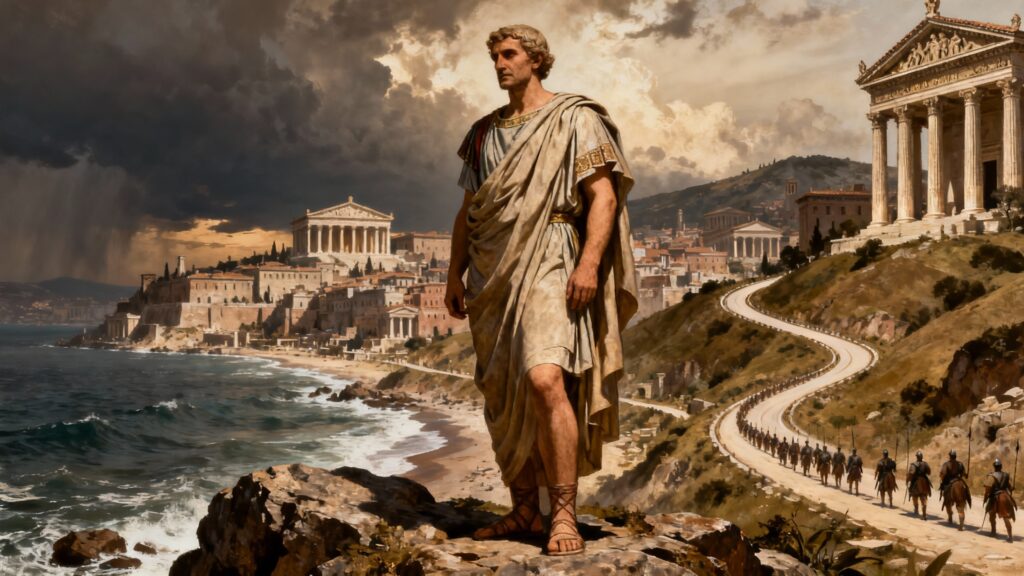Roman Exiles: Stories of Power Lost and Regained explores a defining aspect of Roman political life—exile as both punishment and strategy. In Roman history, exile was more than mere banishment; it was a calculated tool wielded to neutralize political rivals, manage dissent, and reshape power structures.
This article examines how exile shaped personal destinies and broader political dynamics, revealing enduring lessons about the fragility and recovery of power. It also delves into the larger structure of power in the Roman Republic, a system that marked a significant transition in governance from monarchy to a complex political structure. This structure laid the foundation for modern democracies and established key principles of governance that resonate today.
Moreover, the article highlights how infrastructure such as Roman roads played a crucial role in maintaining and expanding the empire. These roads facilitated not only military movements but also cultural exchange and political control.
Additionally, it acknowledges the remarkable achievements in Roman engineering, which served as a foundation for contemporary infrastructure systems.
Finally, while exploring these themes, it’s essential to understand the cultural context shaped by Roman mythology and societal elements such as the role of gladiators in entertainment—figures who were both admired for their skills yet victims of a complex social system (The Gladiators: Heroes or Victims?).
The Political Context of Exile in Ancient Rome
Exile in Roman history was an important tool used during times of political turmoil. It was a punishment usually given to powerful individuals who went against the ruling groups or couldn’t navigate the dangerous world of politics. There are several common reasons why someone might be exiled during this time:
- Accusations of treason, corruption, or conspiracy against the state.
- Defeat in political rivalries and purges carried out by competing factions.
- Losses in civil wars or rebellions that changed the leadership structure.
Exile served as a way to deal with political opponents without immediately killing them. By removing threats from Rome, the center of power, their influence and networks were effectively limited.
Consequences of Exile
The impact on a person’s status was severe. Exile took away their legal rights, social standing, and access to wealth. In Roman society, where reputation and public presence were extremely important, being absent from the scene was like facing political death. However, exile was not always permanent. It allowed for self-reflection, building alliances abroad, or planning comebacks.
Shifts in Power Dynamics
When an elite figure was exiled, the power dynamics shifted dramatically. Their faction became weaker while their rivals gained power. At the same time, exile became a platform for resilience among those seeking restoration through military support or diplomatic actions. This back-and-forth between loss and potential comeback defined much of Rome’s turbulent elite politics during times when rival factions fought for dominance.
Cultural Events During Exile
While exile had serious consequences, it also coincided with significant cultural events in ancient Rome. The spectacle of ancient Rome, which included gladiatorial games, chariot races, and theatrical performances, played a vital role in shaping social relationships and political authority during such chaotic periods.
Legal Foundations of Exile
Additionally, the legal aspects of exile were deeply connected to the Twelve Tables, a significant milestone in the development of Roman law and legal history. These laws were the first attempt to systematize the complex and often arbitrary legal practices of ancient Rome.
Notable Cases of Roman Exiles Who Regained Power
The story of Justinian II stands out as one of the most dramatic examples of Justinian II exile and Byzantine emperor restoration. His reign began in 685 AD but was cut short by a coup that not only deposed him but also subjected him to brutal mutilation—his nose was cut off, a common practice to disqualify a ruler from reclaiming the throne. This physical disfigurement marked him for exile, a harsh punishment meant to end his political career.
Resourcefulness During Exile
Survival during exile required resourcefulness. Justinian II found refuge first with the Bulgars, where he built alliances through diplomacy and marriage. His time in exile was not spent idly; instead, he cultivated military support and prepared for a comeback. This resilience highlights how personal networks and external powers played critical roles in survival beyond Rome’s borders.
The Military Coup and Reclamation
Leveraging these alliances, Justinian orchestrated a military coup with the backing of Bulgar troops. He invaded Constantinople and reclaimed the throne in 705 AD, demonstrating the intricate relationship between exile, external forces, and internal political upheavals. His return reshaped the political landscape, illustrating how exile could be a temporary setback rather than a definitive end to authority.
Lasting Influence on Law and Architecture
Justinian’s reign is also notable for his commissioning of the Corpus Juris Civilis, a comprehensive codification of Roman law that has had a lasting influence on modern legal systems. The military support he garnered during his exile speaks volumes about the role of the Roman army in shaping political outcomes, while his architectural endeavors reflect the masterpieces of Roman architecture that symbolize power and cultural identity. Additionally, his interactions with the wealthy elite, known as patricians, further illustrate the complex socio-political landscape of ancient Rome.

The Avignon Papacy: A Unique Form of Papal Exile
The Avignon Papacy stands out as a remarkable chapter in the history of Roman exiles, where the papal court itself experienced prolonged displacement. From 1309 to 1377, the popes resided not in Rome but in Avignon, France. This relocation was driven by escalating conflicts within Italy and increasing pressure from powerful secular rulers, particularly the French monarchy. The papal court’s exile to Avignon reshaped church governance and altered perceptions of the papacy’s role in European power dynamics.
Effects of the Avignon Exile on the Papacy
Centralization of Church Administration
The move to Avignon coincided with a significant centralization of church bureaucracy. The papal court adopted many practices typical of a royal administration, streamlining decision-making processes and increasing control over ecclesiastical appointments and finances throughout Christendom. This heightened administrative efficiency reflected a shift toward a more institutionalized church government, moving away from the decentralized medieval system that had prevailed in Rome.
French Influence on the Papacy
The physical presence of seven consecutive French popes at Avignon reinforced French dominance over the papal institution. This influence extended beyond mere geography; it affected diplomatic relations, church policies, and even papal elections. Many contemporaries accused the popes during this period of being pawns of French interests rather than independent spiritual leaders serving all Christendom impartially.
Accusations of Corruption and Papal Worldliness
The Avignon Papacy attracted sharp criticism for perceived corruption and excessive worldliness. Critics pointed to the lavish lifestyle maintained by the papal court in Avignon, contrasting starkly with earlier ideals of ecclesiastical poverty and humility. The accumulation of wealth, extensive taxation across Europe, and involvement in secular politics fueled allegations that the church had strayed from its spiritual mission into realms dominated by greed and ambition.
These developments during the papal court exile left a lasting mark on the Catholic Church’s reputation. The period saw both consolidation of papal power through administrative reforms and growing discontent among clergy and laity who viewed the papacy as compromised by its entanglements with secular powers. Understanding this phase sheds light on how exile—whether forced or strategic—can lead to profound transformations in governance structures as well as public perception.
The Avignon Papacy thus exemplifies a unique form of Roman exile where power was not merely lost but relocated and reconfigured under external influences, setting important precedents for future struggles between spiritual authority and temporal power. This historical event also serves as a reminder of the cultural richness that existed during ancient times, reflected in various aspects such as art and culture that thrived even amidst political turmoil.
Return from Exile: Pope Gregory XI and Restoration to Rome
The prolonged papal court exile in Avignon, lasting nearly 70 years, came under intense scrutiny by church leaders and secular rulers alike. Deep dissatisfaction with the French influence on the papacy and growing calls for spiritual renewal created pressure to restore the papal seat to its original home. Pope Gregory XI faced mounting challenges: persistent unrest in Rome, declining papal prestige due to accusations of church corruption and papal worldliness, and political instability fueled by ongoing conflicts between Italian city-states.
Key factors leading to the decision to return include:
- Reassertion of spiritual authority: Rome symbolized the heart of Christianity and represented legitimacy that Avignon could not fully provide.
- Political necessity: The papacy needed to distance itself from its image as a French puppet and regain independence amid rising tensions with secular rulers, especially the King of France.
- Pressure from influential figures: Notably, St. Catherine of Siena’s letters urging Gregory XI to restore the papacy to Rome played a significant role.
The transition back was far from smooth. Gregory XI confronted:
- Hostile Roman factions demanding concessions and reforms.
- Challenges in reestablishing centralized church administration after decades of Avignon Papacy governance structures influenced by French court culture.
- Navigating delicate relations with both French interests and Italian powers seeking influence over the papal return.
Gregory XI’s move marked the end of the Avignon Papacy, setting a complex stage for future struggles within the church’s leadership and territorial control. This period also reflected broader societal changes that were shaping daily life in Ancient Rome, influencing everything from governance to social class divides. As we delve deeper into this historical context, it’s essential to recognize how the legacy of Ancient Rome continues to shape Western civilization today, serving as a foundation for modern legal systems as seen in Roman Law which originated in this era.

Themes Emerging from Roman Exile Narratives
Exile in Roman history reveals distinct patterns among those who lost and later regained power. The experience of displacement from power often forced exiles to develop sophisticated survival strategies in exile. These included cultivating new alliances, leveraging military support, or exploiting political instability back home.
Key themes include:
- Resilience in politics as a critical factor—exiles like Justinian II demonstrated physical and psychological endurance despite mutilation and betrayal.
- Strategic alliances with external forces or rival factions often proved decisive in reclaiming authority.
- The interplay between personal ambition and broader political currents shaped exile outcomes.
Roman exiles embody a complex relationship between vulnerability and agency, illustrating the fragility of power and the potential for restoration. These narratives deepen our understanding of Roman imperial politics by highlighting how exile functioned not only as punishment but also as an opportunity for political recalibration and comeback.
Interestingly, the socio-economic landscape during these exile periods was significantly influenced by various factors, including agriculture, which played a crucial role in Rome’s economic growth. Furthermore, the religious practices of the Romans were not merely a set of beliefs but a comprehensive system that intertwined with every aspect of their lives, influencing politics, culture, and social structures.
The narratives of these exiles also reflect on the legal status of Roman women, revealing a complex interplay of rights and restrictions that significantly influenced gender dynamics in ancient Rome. Additionally, the philosophical underpinnings during this period were shaped by movements like Stoicism, which emphasized living in harmony with nature and using reason as paths to achieving human flourishing.
Roman Exiles: Stories of Power Lost and Regained illuminate resilience as a defining element of political survival in antiquity.
Conclusion
The legacy of Roman exiles offers valuable insights into the power dynamics of ancient Rome. These stories demonstrate that exile was not merely a form of punishment, but rather a battleground where authority was both challenged and restored. The narratives of figures such as Justinian II and the Avignon Papacy exemplify the resilience of individuals in the face of political turmoil.
Here are some key takeaways from our exploration:
- Roman exiles often played pivotal roles in shaping history, using their survival skills and strategic thinking to effect change.
- Their firsthand accounts enhance our comprehension of Roman political history, revealing how exile served as both a weapon and a critical juncture.
- The interaction between personal ambitions and external influences molded the ever-evolving power dynamics, as evidenced by the lives of plebeians, who constituted the majority and wielded considerable impact on political and economic systems.
Roman Exiles: Stories of Power Lost and Regained continue to impart timeless wisdom about perseverance and the intricacies of leadership when confronted with adversity.
FAQs (Frequently Asked Questions)
What was the significance of exile in Roman political history?
Exile in Roman history served as a crucial political tool to manage rival factions and punish elites. It symbolized a loss of power and status, often used to neutralize political threats while allowing the possibility of restoration, reflecting themes of power lost and regained.
How did exile function as a punishment among Roman elites?
Exile was commonly imposed on Roman elites involved in political upheaval or rivalry. It removed individuals from the center of power, diminishing their influence and personal status, yet it also provided an opportunity for survival and strategic planning to reclaim authority.
Who was Justinian II and how did he regain power after exile?
Justinian II was a Byzantine emperor who experienced deposition, mutilation, and exile. During his time away from power, he employed survival strategies including forming military alliances and leveraging external support, which ultimately enabled him to stage a successful return to imperial authority in Rome.
What was the Avignon Papacy and why is it considered a form of papal exile?
The Avignon Papacy (1309–1377) refers to the period when the papal court relocated from Rome to Avignon under French influence. This move is regarded as a unique form of papal exile marked by accusations of church corruption, increased secular entanglements, and centralization of church administration away from Rome.
How did the Avignon Papacy affect church governance and perceptions of the papacy?
During the Avignon period, church governance became more centralized under French control, leading to increased criticism regarding corruption and worldliness within the papacy. These changes impacted the church’s spiritual authority and contributed to tensions between secular rulers and religious leaders.
What led to Pope Gregory XI’s decision to return the papacy to Rome?
Pope Gregory XI decided to end nearly 70 years of papal exile in Avignon due to mounting political conflicts with secular rulers like the King of France, pressures for reform within the church, and challenges faced during the transition back. His return marked a significant restoration of papal authority in Rome.

